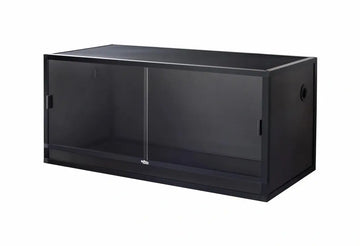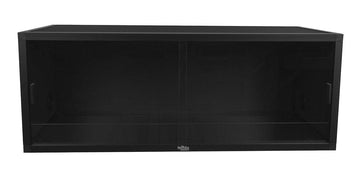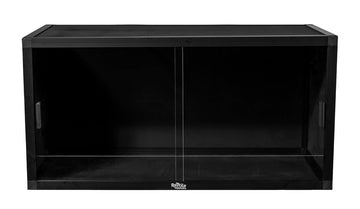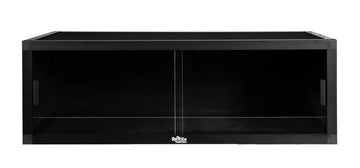Sudan plated lizards (Broadleysaurus major) are 18-24” long terrestrial lizards native to eastern and central Africa. They typically prefer an arid savannah habitat with lots of hills, termite mounds, and rock piles.
These lizards have blunt heads, elongated bodies, strong limbs, and rows of heavily-keeled scales, giving them an armored appearance. They are generally either tan/beige or dark brown/black with thin yellow stripes.
Due to their shy, skittish nature, Sudan plated lizards are best kept as display animals rather than a pet that can be handled regularly. With good care, they can live 15-20 years.
Minimum terrarium size for Sudan plated lizards
The minimum size for housing one Sudan plated lizard is 48”L x 24”W x 24”H. Sudan plated lizards are primarily terrestrial, so plenty of floor space is the main concern. However, they are skilled at low-level climbing, so vertical space will be used if offered. And of course, if you can provide larger, do it!
Multiple Sudan plated lizards should not be housed in one enclosure, as they are not a social species.
Do Sudan plated lizards need UVB?
Yes!
Sudan plated lizards will get sick without UVB as part of their environment. The best UVB bulbs for a Sudan plated lizard in a 48” long enclosure are:
The basking area should be 14-16” below the lamp to give your plated lizard the right amount of UVB. However, if there is mesh between the lamp and your dragon, then the basking area should only be 10-12” below the lamp, because mesh partially blocks UVB rays. For best results, use the Arcadia ProT5 or Vivarium Electronics T5 HO fixture.
UVB is fully blocked by glass and plastic, so you can’t give your lizard UVB by placing its terrarium in front of an open window.
Best temperature for Sudan plated lizards
Sudan plated lizards need a basking temperature of 105-110°F, as measured by an infrared thermometer or digital probe thermometer, with the probe placed on the basking surface. For best results, use a large, flat stone as the basking surface.
Provide heat for your plated lizard with two high-wattage halogen heat lamps placed close together over the basking surface. Do not use ceramic heat emitters (CHEs), red bulbs, blue bulbs, or heat mats, as these are not very effective heating reptiles.
Turn off the heat lamps at night. Temperatures can drop as low as 60°F at night without ill effect, but shouldn’t be warmer than 78°F. Cooler temperatures help them sleep better!
Best humidity levels for Sudan plated lizards
In order to stay adequately hydrated and maintain good scale health, Sudan plated lizards need a humidity gradient between 20-80%. The air should be fairly dry, but they also need free access to a humid burrow or hideout. Increase burrow humidity by pouring water into the substrate with a watering can.
Humidity levels should be monitored with at least two digital probe hygrometers.
Best substrate for Sudan plated lizards
Sudan plated lizards need a layer of substrate at least 4” deep so they can dig and burrow, which is a natural behavior for them. The best substrates for Sudan plated lizards include:
To keep the substrate clean and your lizard healthy, remove old food and waste every day, along with contaminated substrate. You will need to completely remove and replace your substrate every 3-4 months.
How to decorate a Sudan plated lizard terrarium
A barren terrarium is boring to look at and boring for your plated lizard to live in. Make the most of your terrarium by adding a variety of enrichment items for your pet to climb and explore. Here are some ideas:
- climbing logs/branches
- caves
- ledges
- live or artificial plants
- rock stacks
- textured background
What to feed to a Sudan plated lizard
Sudan plated lizards are primarily insectivorous, which means that they eat mostly insects and other invertebrates. However, they are also known to eat some plants, especially fruit. Here’s a basic feeding schedule for your pet Sudan plated lizard:
- Hatchlings (<6” long) — Insects daily, plants daily
- Juveniles (6-12” long) — Insects 5 days/week, plants daily
- Young adults (12-18” long) — Insects 3 days/week, plants 4 days/week
- Adults (>18” long)— Insects 2 days/week, plants 4 days/week, no food 1 day/week
Variety is the key to providing a healthy, balanced diet for your plated lizard. The more variety you can provide, the better!
Feeder insect options for Sudan plated lizards: dubia roaches, discoid roaches, red runner roaches, crickets, black soldier fly larvae, hornworms, mealworms, superworms
Vegetable options for Sudan plated lizards: collard greens, turnip greens, mustard greens, endive, kale, spring mix, dandelion greens, alfalfa, cactus pads, squash, carrots
Fruits can be offered as well, such as berries, figs, apples, prickly pear, papaya, and mango.
Supplements
You will also need calcium and vitamin supplements to help keep your dragon healthy. We recommend Repashy Calcium Plus LoD, lightly dusted on all feeder insects. It’s okay to occasionally skip a dusting.
Water
Of course, don’t forget a medium to large water bowl for your Sudan plated lizard to drink from! Change the water daily and scrub the bowl with a reptile-safe disinfectant weekly, or whenever it becomes soiled.
How to handle your Sudan plated lizard
Reptiles generally don’t appreciate petting and handling in the same way that dogs and cats do. Sudan plated lizards are very shy and skittish, and prefer to keep human interaction to a minimum. However, with patience they can be tamed. Here are some tips for success:
- Start with tong-feeding.
- Don’t grab the lizard from above. Instead, scoop from below.
- Whenever possible, let the lizard come to you rather than chasing after it.
- Support as much of its body as possible, especially the feet.
- Start with short handling sessions at first, then gradually make them longer.
- Put the lizard back in its enclosure only when it’s calm.
*This care sheet contains only very basic information. Although it’s a good introduction, please further your research with high-quality sources. The more you know, the better you will be able to care for your pet! Here are some more sources we recommend checking out:











